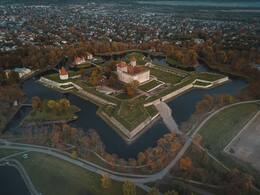Legenda apie užmūrytą riterį
Pasak legendos, 1785 m. vienuolyno pastato planą parengęs rusų inžinierius pilies kiemo rytiniame kampe rado užmūrytą rūsį.
Legenda pasakoja, kad rusų inžinierius, 1785 m. rengęs toje vietoje vienuolyno pastato planus, rytiniame vidinio kiemo kampe aptiko užmūrytą rūsį.
Rūsio viduryje stovėjo masyvus stalas, prie kurio odiniame fotelyje sėdėjo skeletas. Skeletas vilkėjo gražius drabužius, kurie bėgant metams, atrodo, tapo iš rudos į violetinę, ir jojimo batus su atramomis. Ant sienos buvo pakabinta raudona aksominė skrybėlė su balta povo plunksna, šalia jos ant geležinės konsolės sumontuota lempa. Priešais skeletą, ant stalo, buvo molinis puodelis, krūva neįskaitomų lipdytų popierių ir duonos trupinių, o stalo stalčiaus viduje – juodų stiklinių rožinio karoliukų rinkinys. Nuo menkiausio prisilietimo skeletas subyrėjo ant grindų, tačiau piešimo mokytoja iš miesto mokyklos spėjo padaryti riterio eskizus, kol tai neįvyko.
Tai buvo vyskupo įsakymu reformacijos metais rūsyje gyvi įmūryti riterio palaikai. Kadangi Ösel-Wiek katalikų vyskupas buvo linkęs priblokšti savo pavaldinių protestantų, jis kreipėsi pagalbos į Romoje esantį popiežių. Popiežius pasiuntė jam ispaną inkvizitorių, kad įvestų tvarką tarp vasalų. Jo pamaldumą ir ryžtą išbandė vasalai, padovanoję jam šviesiaplaukę mergelę. Riteris merginą įsimylėjo, o tai pažeidė celibato reikalavimą Katalikų bažnyčioje. Afera netrukus tapo vieša, o merginos galva buvo nuskusta prieš išsiunčiant atgailauti į vienuolyną Kaarmoje. Ispanas iš pradžių buvo nubaustas įspėjimu. Tačiau susižavėjęs inkvizitorius nusprendė merginą išlaisvinti iš vienuolyno. Deja, laiškas, kurį jis parašė ir paslėpė duonos gabalėlyje, užuot pasiekęs meilę, atsidūrė ant vyskupo stalo. Tada buvo nuspręsta, kad šis Dievo tarnas paklydo ir nerado išsigelbėjimo, dėl ko buvo gyvas įmūrytas į Kuresarės pilies rūsį. Nuo šio apreiškimo rūsys buvo vadinamas Užtverto riterio rūsiu.
Saremos muziejus
Susijusios vietos
Saremos muziejus
Kuressaare Castle is situated on the southern edge of the Kuressaare town, by the sea.
The anniversary of Saaremaa Museum, which is housed in the fortress, is celebrated on 17 February: the date in 1865 when the Society for Research of Saaremaa (Verain zur Kunde Oesels) was founded. The museum relocated to the castle in 1897. Its exhibition showcases the nature and history of Saaremaa. The largest and most noteworthy exhibit at the museum is the castle itself, which a fine example of the development of military fortifications between the 14th and the 19th centuries. Kuressaare Castle is one of the most authentic fortifications anywhere in Northern Europe.









